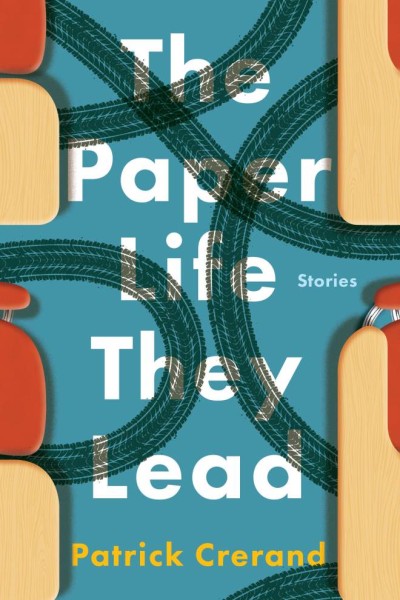
by Emily Webber
In The Paper Life They Lead, Patrick Crerand takes risks in his storytelling, and the result is an inventive collection. In this slim book of just over 50 pages, Crerand’s mixture of flash fiction and slightly longer stories drops the reader into bizarre and unexpected places. Fantastical events occur even when the world looks much like the one we live in. The interesting and weird premises are stated upfront allowing the reader to focus on the characters—their relationships and how they react to the situations they are in.
In “PIT-DAY” the passengers on a commercial airplane deal with a pilot who is suddenly flying them into outer space. In another story, an auction is held at an abandoned zoo with greedy investors. A mother pays the ultimate price while the others look on unconcerned, calling to mind how easy it can be to dismiss another person’s suffering:
The man in khaki lowered his rifle and led the crowd back to the front entrance of the zoo, leaving the mother alone on the brick ledge. In the parking lot, they waited for the valets to bring their vehicles. The women winced from each of the boy’s screams while the men made small talk to cover the noise. Better to put it right out of your mind, they told their wives.
Crerand asks the reader to think beyond what is on the page and relies on his readers to attach their own meaning to these stories. The flash fiction pieces, such as “42 & Lexington” and “The Ear,” seem to ask too much of the reader and do not push past the fantastical premise as well as the other stories in this collection. Crerand’s most successful stories have the bizarre backed by a very real, emotional world. The reader encounters characters who have the same fears and desires that link us as human beings. This emotional component is how Crerand can pull off these wacky scenarios without becoming gimmicky.
“Semi-Love” is the story most grounded in the real world. It tells of two truck drivers as they grapple with the future of their relationship. In one scene, one of them describes the cows she drives to slaughter, and this image comes back to resonate beautifully at the end:
You can tell if it’s going to rain because they’ll be out under a tree like a clump of mushrooms hours before a cloud is in the sky. But they know. When I walk over to the fence, they stand up and those sharp shoulder bones stretch their skin like wet paper. They walk out to see how I am. They’re so stupid. They should run away and hide. ‘I’m the one who drives you to the butcher,’ I say, but they’re drawn to movement and don’t know better. They eat anything if it’s in the grass. Nails, barbed wire, tires. They make the cows swallow a magnet when they’re young to collect all the metal they eat in their first stomach, before it gets to the rest of their insides.
In “The Glory of Keys,” originally published in McSweeney’s, a Pontiac Sunbird takes the place of its owner in high school. While it is hard to truly care for a car as a protagonist, using this technique made the story’s message more apparent. The car rises to the top as a football star and valedictorian and then faces a less glamorous reality post-high school. The reader becomes acutely aware of the way we sometimes randomly raise a person up to hero status and place our hopes on them.
“The Paper Life They Lead” is another of Crerand’s most compelling stories. The life of a father, mother, and their son living on the picture of the Pepperidge Farm packaging is detailed. The bleak setting is revealed in the opening lines:
Morning on the Pepperidge Farm box is not all chocolate and cheese. The three of them—the farmer, his wife, and the boy—dot the whiteness like breadcrumbs on an apron. It is always cold and it is always morning.
The son pushes against the boundaries of his world and dreams of something beyond the repetition of his daily life while his father constantly reminds him:
“This here’s a paper life. Nothing but you, me and your mother. The sooner you see it, the better.”
Throughout this collection, there is an overarching theme of desire, and many of these characters are searching for something while they try to understand their world better. When getting down to the bare bones of these stories, there’s a lot to unpack, and readers will take away different insights.
The Paper Life They Lead is the debut book from Arc Pair Press—a new publisher of “mini-books” of short fiction and nonfiction. Since the release of Crerand’s collection Arc Pair Press has published another collection of short stories and a prose poetry collection, with an essay collection forthcoming in 2019. It’s no trivial undertaking to form a small press, and I’m grateful that Heather Momyer, Arc Pair’s founder, took the plunge and that there exists another outlet for writers to get their work out. This refreshing new press is definitely one to support and keep an eye out for future releases.
_____________________________
 Emily Webber was born and raised in South Florida where she lives with her husband and son. Her writing has appeared or is forthcoming in The Writer magazine, Five Points, Maudlin House, Brevity, Saw Palm, and Slip Lip Magazine. She’s the author of a chapbook of flash fiction, Macerated, from Paper Nautilus Press.
Emily Webber was born and raised in South Florida where she lives with her husband and son. Her writing has appeared or is forthcoming in The Writer magazine, Five Points, Maudlin House, Brevity, Saw Palm, and Slip Lip Magazine. She’s the author of a chapbook of flash fiction, Macerated, from Paper Nautilus Press.

 The core workshop of SmokeLong Fitness is all in writing, so you can take part from anywhere at anytime. We are excited about creating a supportive, consistent and structured environment for flash writers to work on their craft in a community. We are thrilled and proud to say that our workshop participants have won, placed, or been listed in every major flash competition. Community works.
The core workshop of SmokeLong Fitness is all in writing, so you can take part from anywhere at anytime. We are excited about creating a supportive, consistent and structured environment for flash writers to work on their craft in a community. We are thrilled and proud to say that our workshop participants have won, placed, or been listed in every major flash competition. Community works.